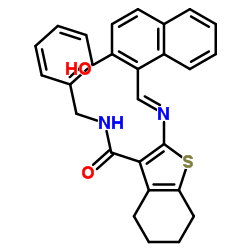1256375-38-8
| Name | jgb1741 |
|---|---|
| Synonyms |
N-Benzyl-2-{(E)-[(2-hydroxy-1-naphthyl)methylene]amino}-4,5,6,7-tetrahydro-1-benzothiophene-3-carboxamide
Benzo[b]thiophene-3-carboxamide, 4,5,6,7-tetrahydro-2-[[(1E)-(2-hydroxy-1-naphthalenyl)methylene]amino]-N-(phenylmethyl)- |
| Description | JGB1741 (ILS-JGB-1741) is a potent and specific SIRT1 activity inhibitor with an IC50 of ∼15 μM. JGB1741 is a weak SIRT2 and SIRT3 inhibitor with an all IC50>100 μM. JGB1741 increases the acetylated p53 levels leading to p53-mediated apoptosis with modulation of Bax/Bcl2 ratio, cytochrome c release and PARP cleavage. JGB1741 has the potential for breast cancer research[1]. |
|---|---|
| Related Catalog | |
| Target |
SIRT1:∼15 μM (IC50) SIRT2:>100 μM (IC50) SIRT3:>100 μM (IC50) |
| In Vitro | JGB1741 (ILS-JGB-1741; 1-10000 nM; 24 h) inhibits MDA-MB 231 cell proliferation[1]. JGB1741 (0.01-1 μM; 24 h) induces apoptosis of MDA-MB 231 cells[1]. JGB1741 (0.01-1 μM; 24 h) shows a cell cycle arrest at G1 phase with more and more cells entering into sub G0/G1 phase[1]. JGB1741 (0.01-1 μM; 24 h) shows an increase in the global acetylation of H3K9, p53 expression and acetylated p53K382 levels[1]. Cell Proliferation Assay[1] Cell Line: K562, HepG2 and MDA-MB 231 cell lines Concentration: 1, 10, 50, 100, 500, 1000, 10000 nM Incubation Time: 24 hours Result: Inhibited MDA-MB 231 cell proliferation more potently with an IC50 of 0.5 μM than K562 and HepG2 cell proliferation (IC50>1 μM). Apoptosis Analysis[1] Cell Line: MDA-MB 231 cells Concentration: 0.01, 0.1, 0.5, 1 μM Incubation Time: Result: Showed an increase in the percent apoptotic cells in a dose-dependent fashion with ∼70% apoptosis at 1 μM concentration. Cell Cycle Analysis[1] Cell Line: MDA-MB 231 cells Concentration: 0.01, 0.1, 0.5, 1 μM Incubation Time: Result: Showed a cell cycle arrest at G1 phase with more and more cells entering into sub G0/G1 phase, the apoptotic phase, in a dose-dependent fashion. Western Blot Analysis[1] Cell Line: MDA-MB 231 cells Concentration: 0.01, 0.1, 0.5, 1 μM Incubation Time: Result: Caused a dose-dependent increase in the global acetylation of H3K9. Showed an increase in both p53 expression and acetylated p53K382 levels. |
| References |
| Density | 1.3±0.1 g/cm3 |
|---|---|
| Boiling Point | 700.2±60.0 °C at 760 mmHg |
| Molecular Formula | C27H24N2O2S |
| Molecular Weight | 440.56 |
| Flash Point | 377.3±32.9 °C |
| Exact Mass | 440.155853 |
| PSA | 89.93000 |
| LogP | 7.31 |
| Vapour Pressure | 0.0±2.3 mmHg at 25°C |
| Index of Refraction | 1.682 |
